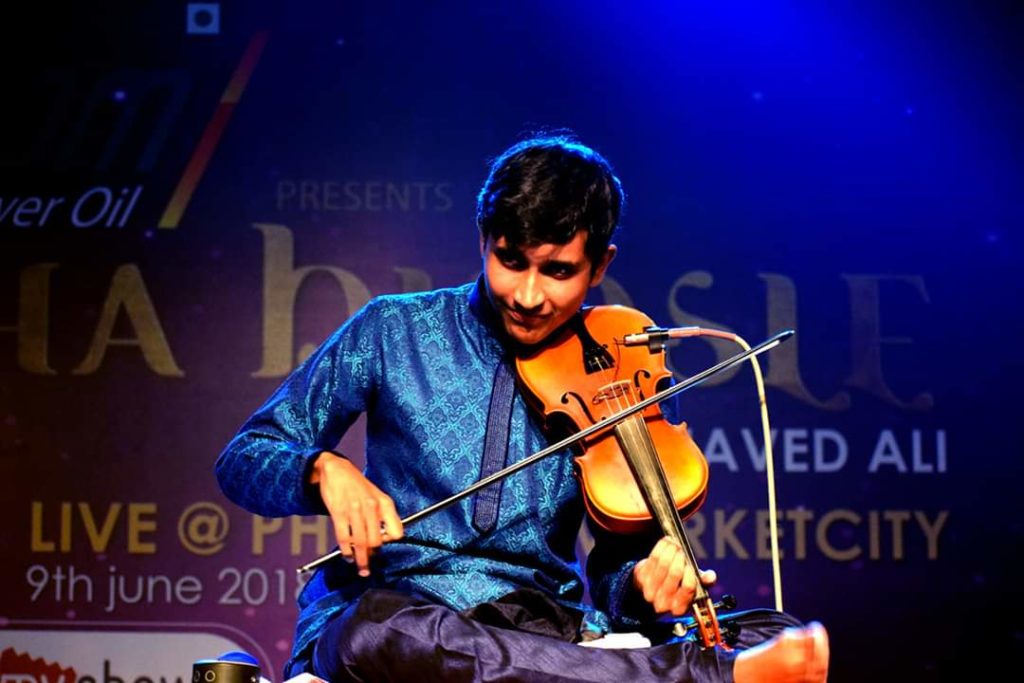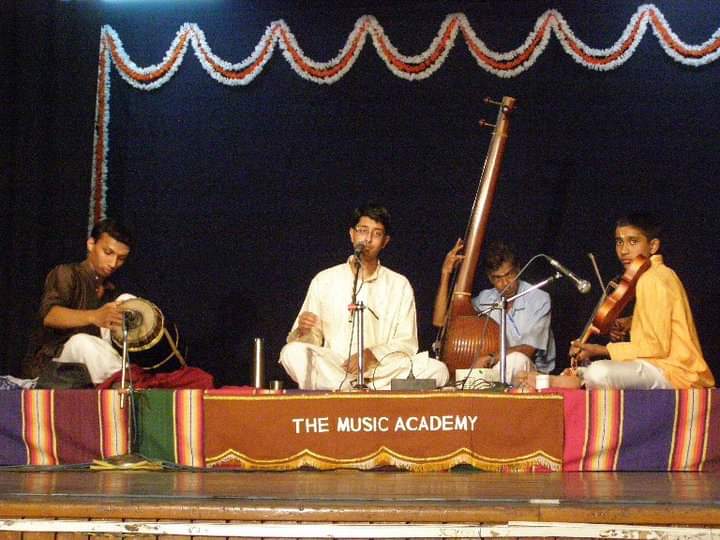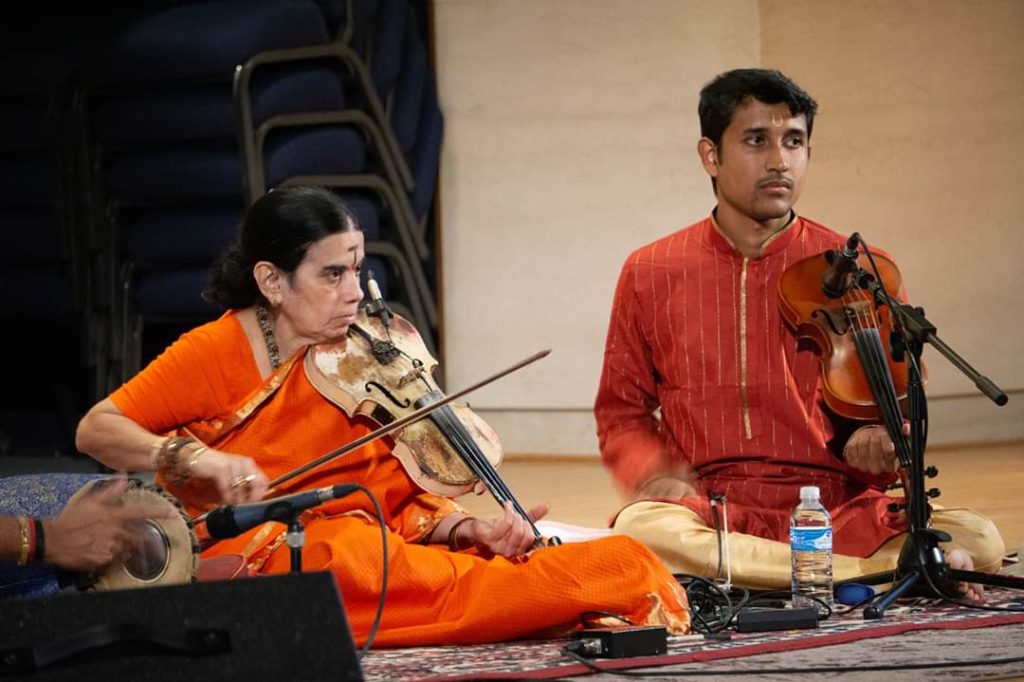B Vittal Rangan

Of this artiste who had over 60 concerts in ~40 days this past music season, Sangita Kalanidhi Aruna Sairam says, “He is an excellent violinist on whom the music world has great expectations. His command over rAga bhAva and dexterity of playing are qualities that make him a very sought-after musician in Carnatic field.” Ranjani and Gayatri state, “He first played for us as a young boy and was self-assured even then. He catches on very quickly even with rarely heard ragas like Basant BahAr, Haricharan and DeepAli and maintains the energy of the concert. His rapid-fire repartees evoke the great maestro Lalgudi Jayaraman.”
25-year-old B Vittal Rangan has accompanied numerous artistes transcending all ages and seniorities including Padma Bhushan RK Srikantan, Padma Bhushan and Sangita Kalanidhi TV Sankaranarayanan, Sangita Kalanidhi N Ramani, OS Thiagarajan, Sangeetha Kala Acharya Neela Ramgopal, Bangalore S Shankar, Malladi Brothers, Ranjani & Gayatri, Kaushiki Chakraborty, Sangita Kalanidhi Sanjay Subrahmanyan, Sangita Kalanidhi N Ravikiran, Sangita Kalanidhi Dr. S Sowmya, TM Krishna, Ramakrishnan Murthy, Vishakha Hari, S Shashank, Sikkil Gurucharan, Abhishek Raghuram, Kunnakudi Balamuralikrishna, S Saketharaman, and many more.
Many thanks to Sri. Vittal Rangan for sharing audio, video and photographs for this page. A version of this article appeared in The Hindu.
Growing up in Bangalore, he began with the harmonium, at age 6, translating what his mother, Chitra Bilvam, sang, and playing in neighbourhood bhajan sessions. Chitra, a graded vocalist of All India Radio, Bangalore, was a student of Sangita Kalanidhi TM Thiagarajan at the Thiruvaiyaru Music College. Even earlier, Vittal could identify several rAgA-s. Chitra enrolled Vittal in 2002 with doyen RR Keshavamurthy for violin lessons. Keshavamurthy guided Vittal awhile until he reached kirtanai-s. He heard Sangita Kalanidhi A Kanyakumari at a concert then and was awestruck by her clarity and ease of playing. “These aspects continue to amaze me,” says Vittal.
27th December 2016, Chennai.
He was enrolled with Kanyakumari in 2003, having classes whenever she visited Bangalore or he travelled to Chennai. There were differences in bowing and fingering techniques from what he had learned earlier, particularly with gamakam-s. “It was a challenge to unlearn. I went to Chennai for two intense weeks of daily classes. This was a significant turning point.”
Kanyakumari focused a lot on reflecting the sahitya of the composition accurately. She also initiated Vittal into manodharmam early on. Vittal first attempted phrases of Mohanam under her guidance (after learning Bhavanuta), which Kanyakumari asked him to try and further develop. “She corrected errors and made suggestions, also alerting me to repetitious phrases,” he explains. For kalpanAswaram-s, to return to tALam, Vittal suggests that learners practice many different endings of varying counts. A prior initial step is playing swaram-s without any kArvai-s and coming back to the starting point.
He listened extensively to vocal recordings and paid attention to how stalwarts had accompanied others. He accompanies his Guru Kanyakumari regularly. “Playing with her is intense learning every single time. It requires tremendous concentration to attempt matching her agility and finesse of play. This really hones my accompanying skills too.” Vittal’s first concert trip to the US was with Kanyakumari in 2019. On a few occasions then, a unique concept – presenting an entire concert in three octaves – was portrayed. Here, they were joined by Rajeev Mukundan and Kamalakiran Vinjamuri, also students of Kanyakumari. “It was a real blessing to travel and share the stage with her on my maiden US tour.” Vittal has also received guidance from his cousins Vishakha Hari and S Saketharaman.

He performed his first solo at age 13 at Ananya, Bangalore. For a few years, he was a part of Bala Brahmam organised by ‘Isai Mazhalai’ Ramjhi. He also regularly accompanied artistes who visited Karnataka, including Bharat Sundar, Sriranjani Santhanagopalan, K Gayatri, the late Ranjani Hebbar, Vignesh Ishwar, Ashwath Narayanan and many more. Vittal deftly sandwiched school between violin sessions even during Grades 10-12, fitting in 3-4 hours of daily practice. He passed all his Chartered Accountancy examinations in the first attempt and has been employed since. “The articleship period was tough – however, I somehow still managed to work, study, practice and perform.” His father was ailing then and passed away soon after.
Sri. NC Bharadwaj on mridangam,
Sri. S Krishna on ghatam.
Vittal particularly stresses the importance of the ‘tristhAyi’ exercise traversing multiple octaves from mandara sthAyi to athi thAra sthAyi as seamlessly as possible – he repeated this 300-400 times daily. “It covers all tensions of the strings, warms up the fingers AND the instrument too – every note is equally spaced and sruthi shuddham emphasized. It can be done in many raga-s, speeds and in akAram and swaram styles.” Vittal continues to do this exercise to the present day, as a warm-up prior to every concert.
Vittal’s mother, being a musician herself, is a constant source of constructive feedback and suggestions. Vittal finds this very useful in the process of self-improvement.
“There is a continuous involuntary absorption process going on when accompanying,” says Vittal who plays for several artistes across a gamut of pAtAntarA-s and bANi-s. “I might not be consciously learning but ideas are constantly seeping in and can just strike impromptu.” When artistes he plays for express preferences, Vittal accompanies in accordance with them. He focuses on enhancing the overall musical experience. “Sometimes that might mean playing to what the percussionists are producing!” he explains with a smile.
He explains the usefulness of breathing technique– “Slow, steady breaths in synchronization with what is being played is most helpful. It gets the mind calm and is particularly useful during rAga AlApanA-s.”
Violinists can face interesting, unexpected challenges. Vittal recollects the first time he played for vocalist Abhishek Raghuram who sang a Pallavi in KalyANi. “It took me a while to figure out what tALam the Pallavi was in,” says Vittal. He paid attention to the placement of the words and its spacing and played it accordingly. “It was actually Rupakam, but put in a different way, perhaps to more appropriately reflect the gait of those lyrics. Even if the tALam is unfamiliar or put differently, the violinist still HAS to respond instantaneously but there might not be enough time to figure out that complexity AND do the necessary mental calculations.” When it comes to kalpanAswaram-s with korvai and kaNakku in such situations, Vittal suggests violinists pay attention to the point at which the vocalist embarks on the kaNakku, using that as a baseline. When korvai-s are not immediately discernible, one can use the arithmetic of the second sequence to figure out the overall calculation. “However, at all times, the rAga bhAvam should be at the forefront.” If playing for artistes he has not played for before, Vittal might study his/her previous programs to align his playing accordingly.

He has played for jugalbandhi-s with Ranjani and Gayatri and Hindustani vocalist Kaushiki Chakraborty at the Gateway of India and Chowdiah Memorial Hall. “It was an enriching learning experience – for instance, to learn how a phrase in Carnatic might be presented in the Hindustani style, the dynamics between the artistes and the give and take in between.” Vittal also narrates a rather amusing incident when he was accompanying his Guru Kanyakumari in Guntur in 2009. “Prior to presenting BhAvayAmi raghurAmam, a rAgamAlikA with 7 ragas, she would do AlApanA-s in all 7. When she was in the 4th raga, mohanam, she turned and said something to me that sounded like “aduththadu vASi” (play the next one). So, I began mukhAri immediately, much to her surprise. What she had, in fact, said was “azhuththamA vASI” (play more forcefully) – which I realised only after the concert.”
Vittal also listens to rock, pop, jazz, R&B and western classical music too, to broaden his base and widen his perspective. “It has helped me further appreciate the nuances and further accent my playing. The swara gnAnam from the Carnatic base has really helped to understand these styles better.” He is exploring fusion as well and has created a track with S Venkataraman, a keyboardist from Bangalore, using Krishnam kalaya saki, a Narayana Teerthar tarangam, as base.
“Vittal is soft-spoken, polite and cultured and exudes a very pleasant vibration on stage. His razor-sharp intellect allows him to respond instantly to any challenge in his own inimitable way in an exquisitely beautiful form. His conception of the raga is so unique and original, without transgressing the Carnatic idiom, that it inspires me and expands my own horizons of musical thought,” summarises Ramakrishnan Murthy.
Good write up Lakshmi. Thanks for posting it here.
But don’t the musicians generally let the accompanists know in advance the, Ragam, thalam and the gait before the concert when they set the RTP?
“It took me a while to figure out what tALam the Pallavi was in”
Please educate me as I would be glad to know the procedure.
Whether an artiste informs her/his co-artistes of the details of an RTP is entirely upto that individual’s prerogative. It is not a requirement.
Good writeup Lakshmiji! Your talent continues to inspire me through your writeups. Thanks much. The flavour of the writeup is as delicious as the artist himself!
Vittal was brought up in music environment.It was that spark that ignited his interest in music & subsequently in violin.I casually predicted & told him before last music season that he would the most sought after violinist from next season,which would become true.